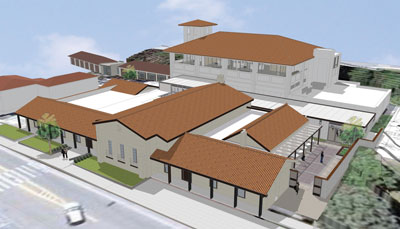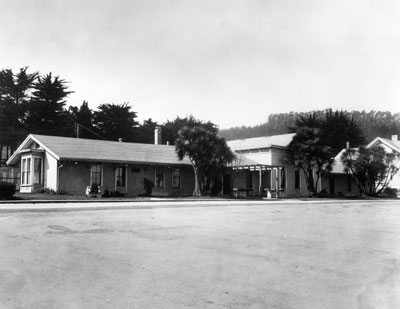Interest
Presidio Officers’ Club gets ready for the next 200 years
December 2011
Presidio Officers’ Club gets ready for the next 200 years
December 2011

A rendering of the completed Officers’ Club rehabilitation
Image: Presidio Trust
In an effort to reestablish the building as the core of our newest national park, the Presidio Trust is rehabilitating the entire Officers’ Club site. It is the first time since the 1930s that the club, one of the oldest buildings in San Francisco, has been upgraded to current safety standards. After the rehabilitation is complete, the Officers’ Club will once again reflect the importance it represented for generations of military families. The total cost of the rehabilitation is an estimated $15 million, with a completion date slated for 2013.

Officers Club before the 1934 remodel
Photo: Presidio Trust archives
The building was first built by the Spanish, then maintained by the Mexicans, was utilized by the United States military, and now serves both residents of and visitors to the Presidio.
According to the Presidio Trust, the first building was destroyed by a major storm in 1779 and then rebuilt, only to sustain major damage from earthquakes in 1808 and 1812.
Original adobe walls that remain are from the rebuilt second building. They were made with soil from El Polin Springs and coated with a lime wash to protect them from moisture.
“The Officers’ Club reveals much about the Presidio’s history as a military post,” said Christina Wallace, the Presidio’s project manager for historic preservation. “From the early adobe construction of the Spanish settlers to wood frame to more modern construction, this building has always been at the center of military life here.”
Portions of the old adobe walls have been uncovered during construction, the first time they have been visible since they were covered over in the late 1880s. Pat Taylor, one of few adobe experts, was commissioned by the Presidio Trust to oversee the adobe repair and will be on site at the Officers’ Club for the next several weeks. Approximately 3,000 adobe bricks will be imported from Arizona to complete the project.
The first room off the entryway, the Mesa Room, is also called the Interpretive Room as its construction and décor reflect different eras. At the far end of this room is the original exposed Spanish adobe; the Mesa Room’s adobe will remain permanently exposed for public viewing while adobe in the other rooms will be covered.
The Officers’ Club is like a layer cake, according to archaeologist Eric Blind, with original adobe, stone and clay at its core and layer upon layer of newer materials added over the centuries.
Closer to the entry of the Mesa Room are wall markings and drawings that reflect primarily the United States military era. There was little if any construction or design left from the Mexican occupation. When the Treaty of Guadalupe Hidalgo in 1848 ceded former Mexican land to the United States, the Presidio became an American military base. Much of the current appearance reveals U.S. influence. The Officers’ Club and the Presidio play a special role in the life of many, including Karen Cook who is currently general counsel to the Presidio Trust. Karen’s father was a career military officer, so Karen spent part of her childhood at the Presidio.
“I lived at Fort Scott from ages 9 through 12, when my father … was stationed here. One of our regular routines was to go to the Officers’ Club for buffet brunch following church on Sunday, and I always thought the building had a certain elegance. We moved out of the Presidio after my father retired from the military, but stayed in the Bay Area and continued frequently to come to the Presidio for shopping at the PX and to visit the Commissary,” Cook said. It was a logical step for Karen and her fiancé, George Ford, to have their wedding and reception at the Presidio in 1979, when the base still belonged to the military.
“When I started planning my wedding, the Presidio still felt like home and just seemed like the obvious place to have it,” she said.
The Cook-Ford nuptials took place at the Presidio Chapel and the reception was in the Officers’ Club Moraga Room, where many Sunday brunches, ceremonies, dinners, and events took place over the years.
As a child, Cook said she didn’t have a “full appreciation for the Presidio’s history, although I do remember that no visit to the Officers’ Club was complete without going to look at the old adobe wall behind the glass panel in the Moraga Room and reading about how old it was.”
“Mostly it was a kids’ paradise because with all the military families there were so many of us! As long as we stayed on the base, we had a lot of freedom to roam. One was never at a loss to find a group to go exploring, especially if it was to places that seemed foreboding, like the coastal batteries!”
Cook has worked for the Presidio Trust since 1998, so as an adult she is able to continue spending her days on the base she loved as a child.
One of the last additions to the Officers’ Club was built in 1972, but has been closed since 2006.
“The second floor, which originally served as a bar and restaurant and was used for special events, is being restored to again host special events. The first floor was mostly used as exhibit space,” said Clay Harrell of the Presidio Trust. Largely unused today, the upper floor boasts one of the premiere views of San Francisco, the Bay and the Presidio.
In 1994, the U.S. military turned the Presidio over to the National Park Service. Since that time, the Presidio has become a National Historic Landmark. According to the Presidio Trust, the Presidio is one of the largest and most ambitious historic preservation projects underway in the United States. Since 1994, approximately 75 percent of the park’s historic structures have been rehabilitated for new uses, resulting in numerous awards for planning and historic preservation.
The work to preserve the building’s adobe walls has earned the Trust a 2011 Preservation Design Award from the California Preservation Foundation. The award recognizes innovative use of technology in preservation. Using thermal-imaging technology similar to that used by fire departments to find hot spots, workers were able to map moisture levels and cavities inside the walls without having to drill into them or tear them down. Guided by these maps, crews are now able to repair the walls with new adobe bricks.
In commenting on the major project of rehabilitating a building that is more than 200 years old, Presidio Trust executive director Craig Middleton looks ahead to the future.
“The Officers’ Club has been the heart of military and social life for over 235 years,” said Middleton. “We are undertaking this rehabilitation to ensure that it will be a place to hold memorable events for generations to come.”


